Exploring FlightCages: A Guide for Bird Owners
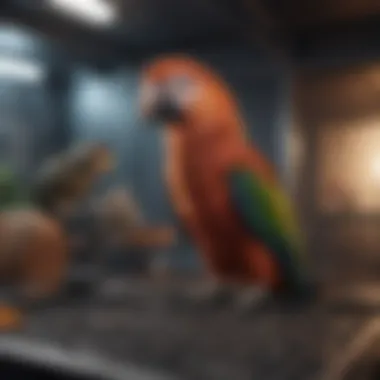
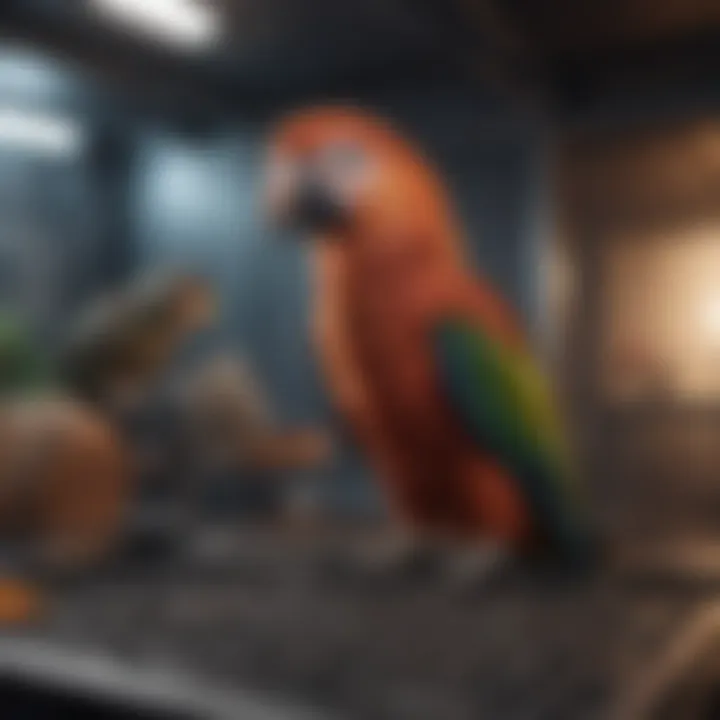
Intro
Understanding flightcages is essential for those who own or care for pet birds. These spacious environments are specially designed to mimic the birds' natural habitats, allowing them to fly and explore. Flightcages offer key benefits such as enhanced physical activity, social interaction, and overall well-being. This article will illuminate the various aspects of flightcages, providing insights on their designs, advantages, and how to choose the right cage for your avian companion.
Adopting a flightcage can transform the living conditions for birds, especially those that thrive on interaction and movement. It plays a crucial role in ensuring that the birds live a healthy and fulfilling life. The following sections will cover essential care tips, behavioral insights, nutrition guides, health considerations, and enriching activities to foster a supportive environment for your feathered friends.
Care Tips
Daily Care Routines
A daily routine is foundational for maintaining your bird's health. Here are some points to consider:
- Fresh Water: Always provide access to clean water. Change it daily to make sure it remains fresh.
- Feeding Schedule: Consistent feeding times help regulate your bird’s appetite and behavior. Notice what times your bird seems most active and coordinate feeding accordingly.
- Social Interaction: Spend time with your bird daily. Birds are social creatures and benefit greatly from human interaction.
Cage Setup and Maintenance
Setting up the flightcage properly is vital for your bird’s happiness. Here are some key considerations:
- Space: Ensure your flightcage is spacious enough to accommodate your bird’s wingspan.
- Perches: Offer a variety of perch sizes and materials. This encourages natural behavior and keeps feet healthy.
- Toys: Include engaging toys for mental stimulation. Rotating toys regularly can help maintain your bird’s interest.
Hygiene and Cleaning Practices
Maintaining a clean environment is not just important for aesthetics but crucial for health.
- Daily Spot Clean: Remove uneaten food and debris from the cage floor and perches.
- Weekly Deep Clean: Wash the cage with bird-safe products. Rinse thoroughly to avoid chemical residues.
- Fecal Monitoring: Regularly check for changes in droppings, as they can signal health issues.
Seasonal Care Adjustments
Seasonal changes can impact your bird’s well-being. Consider the following adaptions:
- Temperature Control: Ensure the cage is in a comfortable environment. Avoid drafts or direct sunlight for long periods.
- Humidity: Birds may require additional humidity in dry seasons. Using a humidifier can be beneficial.
Behavioral Insights
Understanding Bird Body Language
Comprehending how your bird communicates is essential for promoting a positive relationship. Birds use their bodies to express emotions, such as:
- Tail Movements: A fluffed tail often indicates excitement or agitation.
- Wing Position: Lowered wings may suggest relaxation, while raised wings can indicate stress.
Common Behavioral Issues and Solutions
Behavioral problems can emerge from inadequate socialization or environmental stressors. Here are some common issues:
- Feather Plucking: This may occur from boredom or stress. Increasing interaction and providing toys can help.
- Aggression: A sudden change in behavior can signal discomfort. Ensure the bird feels safe and secure in its environment.
Positive Reinforcement Techniques
Using rewards to train behaviors can enhance your relationship:
- Treat Rewards: Use healthy food items as incentives for good behavior.
- Praise and Attention: Verbal praise and petting often motivate birds to repeat positive actions.
Social Interaction Needs
Birds are social animals. Providing opportunities for interaction is fundamental:
- Social Birds: Species like budgerigars or cockatiels thrive on companionship. Ensure they have ample interaction.
- Playdates: Introducing other gentle birds can foster social skills, but supervise interactions carefully.
Nutrition Guides
Essential Diet Components
A balanced diet is key to a bird's well-being. Ensure your bird’s diet includes:
- Pellets: High-quality pellets should form the basis of their diet.
- Fresh Fruits and Vegetables: Varied options provide necessary vitamins and minerals.
Safe and Toxic Foods
Knowing what is safe and what to avoid is crucial for your bird’s health:
- Safe Foods: Carrots, spinach, and apples are generally safe when prepared correctly.
- Toxic Foods: Avocado, chocolate, and caffeine must be avoided completely.
Supplements and Treats
Sometimes birds require additional nutrition:
- Calcium: Offer calcium sources like cuttlefish bone for stronger bones.
- Treats: Occasionally give treats like seeds or dried fruit, but in moderation.
Feeding Strategies for Different Species
Birds have differing dietary needs based on their species. For instance:
- Parrots: Often require a diverse diet rich in fruits and nuts.
- Canaries: Diets suitable for them focus on seeds and greens.
Wellness and Health
Routine Health Checkups
Regular veterinary visits are essential to anticipate health issues:
- Annual Checkups: An experienced avian vet can identify potential concerns that amateur owners might overlook.


Identifying Symptoms of Illness
Being aware of subtle changes can save your bird’s life:
- Behavior Changes: An increase in lethargy or changes in eating habits may indicate illness.
Preventative Care and Vaccinations
Preventative measures are critical for long-term health. Vaccinations can protect against common avian diseases. Consult your veterinarian for a vaccination schedule.
Mental and Emotional Well-being
Providing stimulating environments is key to emotional health:
- Enrichment Activities: Regular changes in toys and activities sustain birds’ mental health.
Enriching Activities
Toys and Playtime Ideas
Toys are vital for reducing boredom. Consider:
- Interactive Toys: Toys that challenge your bird mentally, such as puzzles, can enhance activity.
Training and Tricks
Teaching your bird simple tricks can be rewarding:
- Step Up Training: A basic trick that fosters interaction.
- Follow the Leader: A game where the bird mimics your movements can boost engagement.
Outdoor Activities and Interaction
Birds can enjoy nature with safe outdoor interactions:
- Harness Training: Teach your bird to wear a harness safely for outside adventures.
DIY Projects for Mental Stimulation
Creating your own enrichment can be cost-effective:
- Homemade Toys: Use safe household items, such as paper towel rolls, for creating engaging toys.
Flightcages not only improve physical health but also promote well-being through stimulation and socialization. It is essential for bird owners to recognize and implement ways to enrich their birds' lives.
This article serves as a foundation for providing a nurturing environment for your avian companions, enhancing their enjoyment and promoting their health through informed choices.
Preamble to FlightCages
Understanding flightcages is crucial for pet bird owners and avian enthusiasts. These structures serve more than just a simple housing purpose. They allow birds to express their natural behaviors, promoting well-being through ample space and enrichments. As we delve into the specifics of flightcages, it is important to acknowledge their role in the daily lives of birds. This section sets the groundwork for appreciating the advantage offered by flightcages in comparison to traditional cages.
Defining FlightCages
A flightcage is typically larger than conventional bird cages. It is designed to provide birds with the freedom to fly short distances, encouraging movement and stimulating natural behaviors. The standard dimensions for these cages often vary based on the type and size of the bird housed inside. Flightcages can range from vertical to horizontal layouts, allowing flexibility in how birds utilize their space.
Moreover, flightcages often include various features such as multiple perches, toys, and climbing opportunities. This design approach aims to keep birds physically active and mentally stimulated. Flightcages can be constructed with wire mesh frames or other materials that prioritize visibility while ensuring security.
Distinction Between FlightCages and Traditional Cages
The primary distinction between flightcages and traditional cages lies in their purpose and structure. Traditional cages tend to be much smaller, focusing primarily on confinement rather than the enrichment of the bird's lifestyle. In contrast, flightcages cater to the requirement for space and activity.
- Space Utilization: Flightcages usually offer a larger volume and surface area for birds to move. This is vital for birds that naturally engage in flying.
- Activity Encouragement: Unlike traditional cages, which can restrict movement, flightcages promote physical activity, lowering the risk of obesity and related health issues.
- Social Interaction: Many flightcages come equipped with multiple access points, accommodating more than one bird. This facilitates interaction, enhancing their social experience compared to the limited space of traditional cages.
"Choosing the right cage type can greatly impact your bird’s behavior and overall health."
The importance of these distinctions cannot be understated. They help pet owners make informed decisions that cater to their birds’ needs, benefiting their overall health and happiness. Having a well-structured flightcage can create a stimulating environment, encouraging positive behavior that is often absent in traditional cages.
Benefits of FlightCages for Pet Birds
When considering the well-being of pet birds, the benefits of flightcages cannot be overstated. These cages are designed to facilitate natural behavior, promote physical health, and create an enriching environment. This section discusses the essential advantages flightcages offer for avian companions.
Enhancing Physical Activity
One of the primary advantages of flightcages is the encouragement of physical activity. Unlike traditional cages, flightcages provide ample space for birds to stretch their wings and engage in flight. This can significantly improve their overall health, as regular exercise is vital for avian species.
Birds that have the opportunity to fly tend to have stronger muscles and better cardiovascular fitness. With larger spaces and perches placed strategically, flightcages can help birds mimic their natural behaviors. Additionally, the design can include various levels and platforms, maintaining the birds’ interest and physical engagement.
Here are some key points to consider:
- Increased exercise: Flight encourages exercise which is critical for preventing obesity.
- Muscle development: Birds develop stronger muscles from flying.
- Bone density: Regular activity can enhance bone density, crucial for overall health.
Promoting Mental Health
Mental well-being in birds is just as important as physical health. Flightcages contribute to better mental health by providing an environment rich in exploration opportunities. When birds are able to fly freely, they exhibit more natural behaviors like playing and exploring.
This freedom can reduce stress and feelings of confinement. Birds in flightcages are less likely to exhibit undesirable behaviors such as feather plucking or excessive screeching, which often stem from boredom or anxiety.
Important elements of mental health benefits include:
- Enrichment: A variety of toys and perches stimulates the mind.
- Reduction in behavioral issues: Active birds are less prone to stress-related behaviors.
- Social interactions: Flightcages allow for better interactions among multiple birds if housed together.
Facilitating Socialization
Socialization is crucial for pet birds. Flightcages facilitate meaningful interactions with their owners and other birds. The layout of these cages often promotes easier access for play and bonding activities. Birds that socialize regularly are typically more confident and well-adjusted.
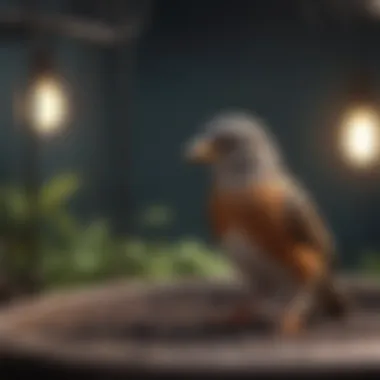
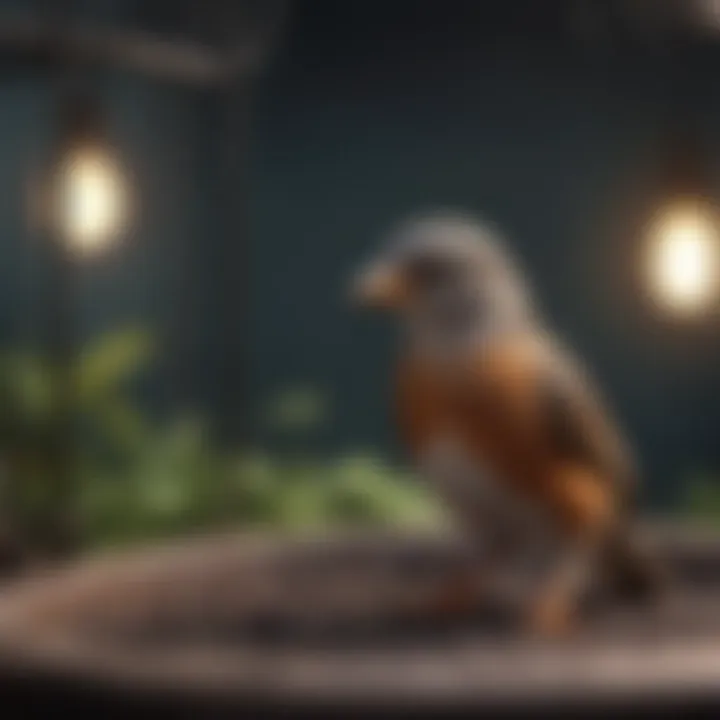
Having sufficient space in the flightcage encourages birds to engage in social behaviors, whether it’s with others of their kind or family members. This helps to create a more harmonious living environment and strengthens the human-animal bond.
Additionally, these cages can be designed to have areas where birds can comfortably observe their surroundings. This allows them to interact more with their human companions, further enhancing social connections.
In summary, the benefits of flightcages extend well beyond basic housing. They contribute to physical activity, mental health, and socialization. By understanding these advantages, avian enthusiasts can make informed decisions, optimizing their birds' living conditions for a vibrant and healthy life.
Design Considerations for FlightCages
When it comes to enhancing the well-being of pet birds, the design of a flight cage plays a crucial role. Flight cages are not just larger enclosures; they are specifically crafted environments that cater to the unique needs of birds. A well-designed flight cage can positively impact a bird’s physical health, mental well-being, and overall happiness. Understanding the elements of design is essential for any bird owner, aspiring bird parent, or bird breeder.
Size and Dimensions
The size of a flight cage cannot be overstated. Birds require ample space to move, stretch their wings, and engage in natural behaviors. The height, width, and depth of the cage are important factors to consider. For instance, larger birds such as macaws or cockatoos benefit from vertical space as they are natural climbers. A general rule is that the cage should be at least two times the wingspan of the bird in width and height.
It is advisable to think about the bird's species when selecting a cage. Smaller birds may not need as much space, but they thrive when given the opportunity to explore. A wider cage allows for more perches and toys, which helps keep the bird entertained. Generally, a flight cage should have a floor area of at least 4 square feet for small birds and much more for larger species.
Material and Construction Quality
The materials used in constructing a flight cage are significant for both safety and durability. Stainless steel is often considered the best option, as it does not rust or corrode. It is also non-toxic, which is crucial for bird safety. Powder-coated finishes can also be safe but should be checked for harmful chemicals.
Additionally, the construction quality must be robust enough to withstand the activities of the birds. Perches, toys, and other accessories can cause wear over time. A sturdy design reduces the risk of the cage collapsing or breaking, providing peace of mind to the owner.
Accessibility and Ease of Cleaning
Maintaining a flight cage is an ongoing task. A well-designed cage should be easy to access for both the birds and the owner. Wide doors and removable trays can facilitate easier cleaning and upkeep. It is important to choose a flight cage that allows for easy removal of bedding and droppings, as hygiene is vital for the health of pet birds.
Furthermore, the interior layout should enable convenient access for adding food and water. Regular cleaning can help prevent illnesses and ensure a healthier living environment. Bird owners should look for cages with features that make their care duties less labor-intensive.
Safety Features
Safety cannot be overlooked in the design of a flight cage. The spacing of the bars is crucial to prevent the bird from escaping or getting stuck. A common guideline is to have a spacing of no more than 1 inch for small birds. Additionally, the edges should be smooth and rounded to eliminate any risk of injury.
It is also beneficial to have features such as locks on doors to prevent accidental escapes. Any added accessories like swings or ladders should be securely attached and free from sharp edges. Ensuring that the cage meets safety standards not only protects the birds but also allows owners to feel secure in their pet's environments.
Important Note: Always check manufacturer guidelines and recommendations to ensure that cages meet the safety needs of your specific bird species.
The considerations discussed provide an essential framework for choosing the right flight cage. Each element plays a part in creating a safe, comfortable, and engaging environment for pet birds.
Choosing the Right FlightCage
Choosing the right flightcage is crucial for the well-being of pet birds. A properly sized and designed cage can contribute significantly to their health, happiness, and overall quality of life. It serves as not just a living space, but also as an environment that can stimulate physical activity, promote social interactions, and facilitate a healthy lifestyle. In this part of the guide, we will explore key factors to consider, allowing avian enthusiasts to make well-informed choices when selecting a flightcage.
Assessing Bird Size and Species Needs
Each bird species comes with its unique size and behavioral traits. To ensure their well-being, it is essential to assess their specific needs before finalizing a flightcage. Larger birds such as macaws or cockatoos will need more space compared to smaller species like finches or canaries. In general:
- Larger species should have cages that allow for vertical and horizontal flight, promoting essential exercise.
- Smaller birds may require enclosures with more perches and toys, as they will naturally spend more time on these than flying.
Furthermore, consider how active your bird is. Some species, like parakeets, love to fly and play, which means a more expansive cage is necessary to accommodate their behaviors. Conversely, some birds may feel more secure in slightly smaller enclosures. Understanding these differences can guide you toward selecting the most suitable flightcage.
Evaluating Available Space at Home
Assessing the available space in your home is another critical factor in choosing a flightcage. A cage should fit comfortably in your living area without overcrowding the space. Here are some points to keep in mind:
- Measure the area where you plan to place the cage. Consider height, width, and depth to ensure that the selected flightcage does not overwhelm the room.
- Ensure that it is easily accessible for regular maintenance, such as cleaning and providing food.
- Avoid choosing a cage that is too close to heat sources or windows, as these can create unfavorable environmental conditions for your pet bird.
Taking these aspects into account will help ensure that both your bird and home environment are harmonious.
Budget Considerations
Budget is an important element when deciding on a flightcage. It is vital to find a balance between quality and cost. Cheaper options may not provide the safety and durability that birds need. Thus, consider the following:
- Set a realistic budget range based on your financial situation but remain flexible enough to invest in a quality flightcage that meets your bird’s needs.
- Research different brands and models, taking note of features that enhance safety, ease of cleaning, and overall design. Higher-priced models often come with better materials and safety features.
- Check for warranties or guarantees before making a purchase, as these can save money in the long run if replacements or repairs are needed.
By being aware of your budget, you ensure that you make a practical choice that serves both your financial situation and your bird’s welfare.
Setting Up the FlightCage
Setting up a flightcage is crucial for the well-being of pet birds. This section focuses on various aspects that contribute to a harmonious environment for avian companions. A thoughtfully assembled flightcage not only enhances comfort but also promotes avian behaviors that are essential for their health.
Creating a Comfortable Environment
Creating a comfortable environment in a flightcage involves various factors. The ambiance should mimic a bird's natural habitat as closely as possible. Use natural materials such as wood for perches. Avoid toxic substances, as birds are sensitive to many common materials.
Temperature control is also vital. Install the cage in a place with a stable climate, away from drafts or direct sunlight. Providing sufficient space allows your bird to spread its wings and move freely.
Adding soft and absorbent flooring mats is another suggestion. These can help reduce noise and retain warmth, making the environment cozy.
Choosing Perches and Toys
Perches should differ in size and texture. Diversity keeps your birds engaged and promotes exercise. Natural branches are an excellent choice as they encourage climbing. Make sure perches are placed at various heights to stimulate movement.
Toys play a significant role as well. Select toys that encourage chewing, climbing, and problem-solving. Rotate toys regularly to maintain interest. Aim for a mix of simple and complex toys, ensuring mental stimulation throughout the day.
Providing Nutritional Access
Access to food and water should be straightforward. Use easy-to-clean bowls and provide fresh water daily. Avoid placing food bowls in corners where they can become dirty quickly.
Consider using varied food types. Pellet diets are common, but adding fresh fruits and vegetables can greatly improve a bird’s health. Be cautious with foods that are harmful to birds: avoid avocado, chocolate, and caffeine, among others. Regularly check food and water containers to ensure they are clean and full.
By ensuring the flightcage is an inviting space, you encourage your birds to explore, play, and thrive.
In summary, setting up a flightcage is not simply about placing it in the correct spot. It requires careful thought about comfort, engagement, and nutrition. Each element plays a significant role in enhancing the overall quality of life for pet birds.
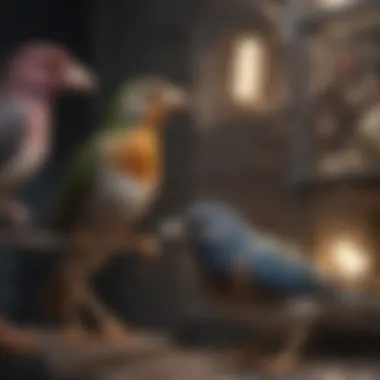
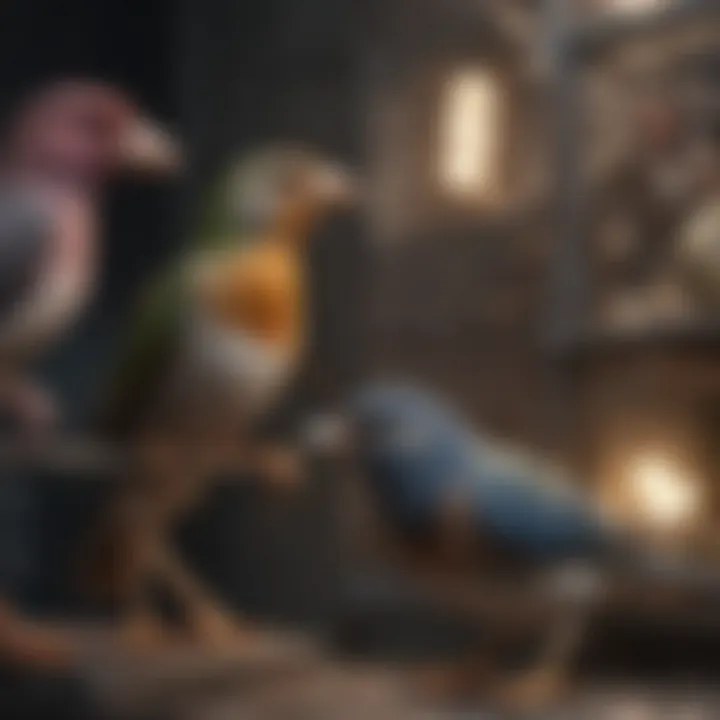
Maintaining a FlightCage
Maintaining a flightcage is critical for the well-being of pet birds. A well-kept cage contributes directly to the health of the birds. Proper maintenance helps prevent illness, ensures an enjoyable environment, and keeps the cage looking good. Adhering to certain routines can make a significant difference.
Regular Cleaning Protocols
Regular cleaning is imperative to prevent the build-up of waste, feathers, and food particles. Unclean conditions can lead to bacterial growth, which poses a significant health risk for birds. Consider these cleaning steps:
- Daily Cleaning: Remove leftover food and waste daily. Use a damp cloth to wipe down surfaces.
- Weekly Deep Cleaning: Once a week, remove all accessories. Wash the cage with bird-safe cleaners. Rinse thoroughly to remove any residue. Dry completely before reassembling.
- Monthly Maintenance: Inspect for wear and tear. Replace essential components such as perches or toys when necessary.
Ensure you use cleaning materials that are non-toxic and free of strong chemicals. This is vital for maintaining a safe environment for your birds.
Monitoring Bird Health
Another critical aspect of maintaining a flightcage is monitoring the health of the birds themselves. Regular health checks can help catch any potential issues early on.
- Daily Observations: Look for changes in behavior, appetite, or weight. Healthy birds are generally active and curious.
- Routine Vet Visits: Schedule regular check-ups with a veterinarian that specializes in avian care. They can advise on vaccinations and health assessments.
- Recognizing Signs of Illness: Be aware of symptoms like ruffled feathers, lethargy, or changes in droppings. Immediate attention may be necessary.
Taking the time to monitor your birds' health can lead to a longer life and more happiness for both the owner and the pet.
Updating Cage Accessories
Updating cage accessories is an essential part of maintaining a flightcage. Accessories play an important role in the comfort and entertainment of the birds.
- Rotate Toys and Perches: Change toys regularly to keep the environment stimulating. Birds are intelligent and can get bored easily.
- Upgrade to Safe Materials: As accessories wear out, replace them with safe, non-toxic materials. Avoid materials that can splinter or break easily.
- Adjust for Size Changes: As birds grow, their needs may change. Ensure that perches are the right size and that toys fit their current developmental stage.
Regularly updating cage accessories not only supports physical health but also promotes mental stimulation.
Maintaining a flightcage is about more than just cleanliness; it is an ongoing commitment to the health and happiness of pet birds. By establishing a routine that prioritizes these maintenance aspects, bird owners can significantly enhance the quality of life for their feathered companions.
Common Myths About FlightCages
Understanding myths about flightcages is crucial for current and prospective bird owners. These misconceptions can lead to poor decisions regarding bird housing, ultimately compromising the health and happiness of avian companions. Debunking these myths helps clarify the benefits that flightcages can provide and encourages informed choices. Below, we explore three prevalent myths surrounding flightcages, explaining why they are unfounded and emphasizing the importance of proper bird housing.
FlightCages Are Too Expensive
A common belief is that flightcages are prohibitively expensive compared to smaller, traditional cages. While initial costs may seem higher, it is vital to consider the long-term benefits and savings. Flightcages often accommodate more bird activity, which can reduce health issues associated with confinement. They can also be more durable, extending their lifespan beyond that of standard cages.
- Investment in health: The price of a flightcage often reflects its quality and capacity to support physical activity. Birds that have room to fly generally experience fewer health problems, potentially saving on veterinary expenses.
- Variety of options: The market offers various flightcage models across different price ranges, making it possible to find a suitable one within any budget.
This myth overlooks not just the qualitative benefits of adequate space for birds but also the potential cost savings in terms of health and well-being.
Birds Prefer Small Spaces
Another prevalent myth is that birds prefer small, confined spaces. This stems from the behavior of some pet birds, which may appear comfortable in a smaller area. However, this observation does not reflect their natural instincts or needs. In the wild, birds thrive in expansive environments where they can fly freely.
- Need for movement: Birds in flightcages may exhibit healthier behaviors, such as exercising and exploring, which are crucial for their physical and mental well-being.
- Behavioral observations: Birds with access to larger cages show less stress, which is evident in their social interactions and overall demeanor.
This myth undermines the inherent needs of pet birds and their instinctual behaviors which natural environments foster.
FlightCages Cause Stress
Some owners believe that flightcages might overwhelm birds and cause stress due to a larger environment. In fact, a well-designed flightcage can provide a safe haven for birds, reducing the anxiety that may arise from being kept in cramped quarters.
- Security and design: Flightcages can be equipped with ample perches, toys, and hiding spots, creating an enriched environment that fosters comfort rather than anxiety.
- Controlled environment: Larger cages allow for more interactive play and exploration, reducing stress triggers such as boredom or confinement.
Overall, the design and setup of a flightcage can enhance the well-being of pet birds, debunking the notion that larger spaces inherently cause distress.
"Understanding these myths is essential for creating the healthiest living environments for pet birds."
By clarifying these misconceptions, pet bird owners can make informed choices that prioritize their companion’s health and happiness.
Finale
Understanding the significance of flightcages is crucial for avian enthusiasts. The numerous benefits they provide cannot be understated. These structures encourage birds to engage in natural behaviors, promoting both physical well-being and mental health. A well-designed flightcage allows for ample space, facilitating exercise and reducing stress.
Summation of FlightCage Advantages
The advantages of flightcages extend beyond mere aesthetics. They offer:
- Greater Space: Unlike traditional cages, flightcages provide ample room for birds to fly, climb, and explore.
- Enhanced Health: Regular exercise improves cardiovascular health, reducing the risk of obesity-related issues.
- Positive Behavior: Birds in flightcages show fewer signs of boredom, aggression, and depression due to their stimulating environment.
- Social Interaction: These cages are also conducive to socialization, allowing birds to interact more freely with their owners and other pets.
In essence, the advantages of flightcages position them as an excellent investment for bird owners seeking to enhance the quality of life for their avian companions.
Future Perspectives in Bird Housing
The future of bird housing is poised for transformation as advancements in design and materials emerge. Expectations include:
- Innovative Designs: Flightcages will likely evolve into more versatile structures that blend seamlessly with home interiors while providing optimal space for birds.
- Smart Technology: Incorporating technology - such as climate control and monitoring systems - will allow owners to maintain ideal living conditions for their birds.
- Sustainable Materials: The focus on sustainability will guide manufacturers to create eco-friendly flightcages that are safe for both birds and the environment.
As society becomes more aware of the needs of pet birds, these improvements will continue to elevate the standards of bird housing. It is essential for bird owners to stay informed about these developments to choose the best options for their pets.
Books on Avian Care
Books provide a foundational knowledge about bird ownership. They cover a range of topics, from bird nutrition to behavioral understanding. Some recommended titles include:
- The New Bird Owner's Guide by Jennifer L. Smith
- Bird Care Basics by Dr. Sally Smith
- The Complete Guide to Bird Care by Dr. T. S. Jones
These works delve into the specifics of proper upkeep for various species. They also detail the anatomy and needs of birds that can aid in optimizing flightcage setups. Furthermore, these resources can be useful for first-time pet owners seeking guidance, as well as seasoned bird enthusiasts.
Online Forums and Communities
The digital age has brought connections among pet bird owners. Online forums and communities serve as active hubs for discussion and support. Platforms such as
Reddit and Facebook groups allow for instant sharing of ideas and experiences.
Engagement with such communities encourages sharing of care tips, flightcage modifications, and personal stories about flightcage benefits. It fosters a sense of belonging and can enhance the experience of bird ownership. These interactions also provide a space for solving common issues through peer support.
Professional Avian Services
Seeking expert advice can greatly enhance the quality of bird care. Professional avian services include veterinarians specializing in birds, trainers who provide socialization techniques, and consultation services for animal behavior issues.
These professionals offer critical insights into health screenings and specific needs related to flightcage integration. They also assist in providing a tailored approach to meeting individual bird needs. Contacting local avian vets can also yield recommendations for qualified trainers and behaviorists.
Engaging with professional services ensures that bird owners take informed steps in providing care.
In summary, exploring these additional resources can equip pet bird owners with valuable knowledge. They enable informed decision-making related to flightcages and overall bird welfare, ultimately contributing to a better environment for avian companions.















